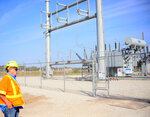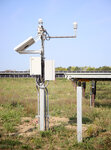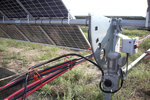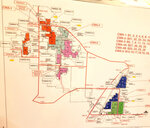






LEE COUNTY – A drive through northeast Lee County shows the current collaboration between agriculture and energy generation industries. With solar panels gleaming above the stalks of corn and bean bushes weeks from harvest creates a powerful landscape in the county.
Alliant Energy began testing last week with a 150-megawatt solar project in Lee County. The footprint, which is more than six miles across as the crow flies, is the second largest solar project in the state of Iowa. The largest is the Duane Arnold Solar Project in Linn County.
According to an Alliant spokesperson, the project has generated an investment of a quarter of a billion dollars. And while the full capacity of the project hasn’t yet been realized due to additional testing required, the project is already producing about 97 megawatts without the full field turned on. Alliant officials anticipate close to 316,000 megawatt hours in the first year alone, enough to power 30,000 homes.
Construction started late in 2023 and slowed down for the winter, but ramped up again in the spring.
“In total it will be approximately one year from the time we broke ground to the time we expect to place the project into service,” said Chris Caporale, a communication specialist with Alliant. “We expect to be fully operational this year.”
He said more testing and commissioning is needed before sections can be put online and then the final step is reliability and performance testing to ensure everything functions properly over extended periods of time and produces expected energy.
“So far, the test power we’ve generated has been lining up with our expectations,” he said.
Most people see the solar fields in Green Bay bottoms and on property leased from landowners north of the Iowa Fertilizer Co. in Wever. But a larger portion of the solar field is located east and west of 330th Avenue and north of 175th Street. There are six clusters of solar panels from near the 1500 block of 330th Avenue all the way east and south into the bottoms.
The project includes approximately 278,000 solar panels with 29 modules hooked together in “strings” that are independently controlled, allowing them to pivot to stay in line with solar rays from the sun.
The field also includes 37 inverters. Those are critical above-ground cabinets that convert direct current (DC) energy from the solar panels, to alternating current (AC) energy that can be used by electric grids. The inverters were provided by Siemens Gamesa.
All the energy created by the 278,000 panels is transmitted through above-ground cabling to large conversion stations and then taken underground through bored cabling that runs the full distance to the substation located just off the northwest corner of IFC.
There are no storage batteries that will be part of the project, however it could be part of future plans at the facility, Caporale said.
“Batteries are a safe and highly-regulated energy resource that can support the power grid and deliver the reliability our customers need. Standards in construction, installation, and operation of batteries have changed significantly in the last several years,” he said.
“Our current construction scope does not include battery storage in Wever, however, it remains a possibility at a later date.”
At the peak of construction, more than 300 people were working on different aspects of the project. On good days, teams could install more than 1,000 panels a day.
Caporale said weather was an impediment temporarily but the project moved according to overall timelines.
“We’ve experienced an abundance of rain this year, which being outdoor projects, can have an impact on production for a few days, but nothing out of the ordinary,” he said.
The strong working relationship with Lee County and its landowners has been a critical part of the project success and any future plans, Caporale said.
“We are working every day to meet the current and future needs of all our customers in Iowa. Here in Lee County, we have found landowners that want to help and a local government that is willing to partner with us and be part of the solution to a clean energy future,” he said.
“The Lee County government has balanced the need for energy infrastructure while also taking the time to make sure residents are protected and safe. That’s a balance we see and one that we also value.”
Lee County Engineer Ben Hull said he agreed with the assessment of the collaboration.
"It wasn't without incident, but we had a praoctive relationship in place to handle what did come up and I would agree with the characterization it's a strong example of good cooperative work," Hull said.
Caporale stopped short of saying the project will directly lower energy costs for local home and business owners, but said the projects do provide a lowest-cost option to ensure energy production for the future.
“Once renewable projects are constructed, we see lower operating and maintenance costs associated with these facilities,” he said.
“In other words, installing solar now is more cost-effective than continuing to maintain and operate traditional energy sources, like coal. Solar projects take no fuel inputs, such as coal or natural gas, and require just a handful of workers to maintain.”
Alliant has received Platinum awards from a non-governmental industry monitoring group for its stewardship in creating the projects.
“Five of our similar solar projects in Wisconsin have received Platinum Certification from the Institute for Sustainable Infrastructure. ISI says this Envision framework encourages systemic changes in the planning, design, and delivery of civil infrastructure to promote sustainability, resilience, and equity through education, training, and third-party verification,” Caporale said.
He said Alliant plansto submit the Lee County project for the award, as well, but that won’t be until late in 2025.
According to the U.S. Department of Energy, solar could help put the United States on a net carbon-free electrical grid in the next 11 years, but it would require 5.7 million acres, or about .3% of the contiguous land in the U.S. to get current solar technology to that level of production.
Other items that may interest you

Comments
No comments on this item Please log in to comment by clicking here